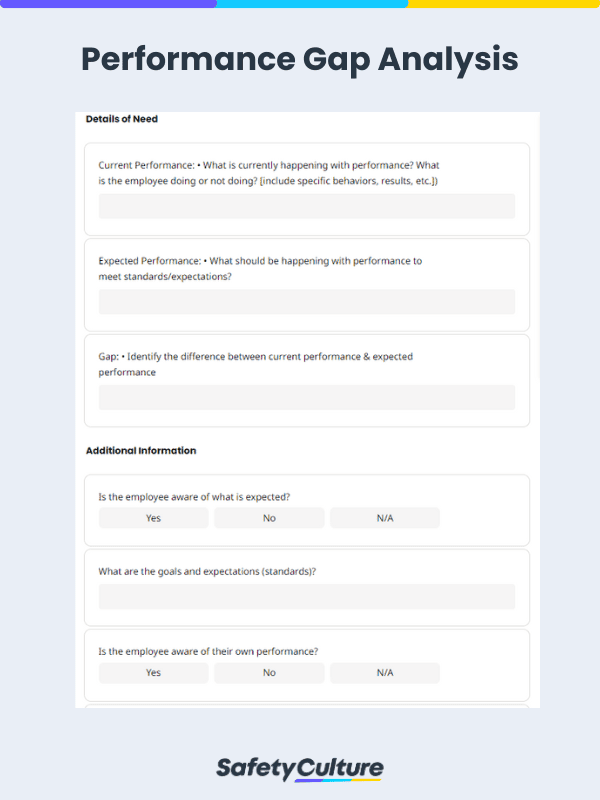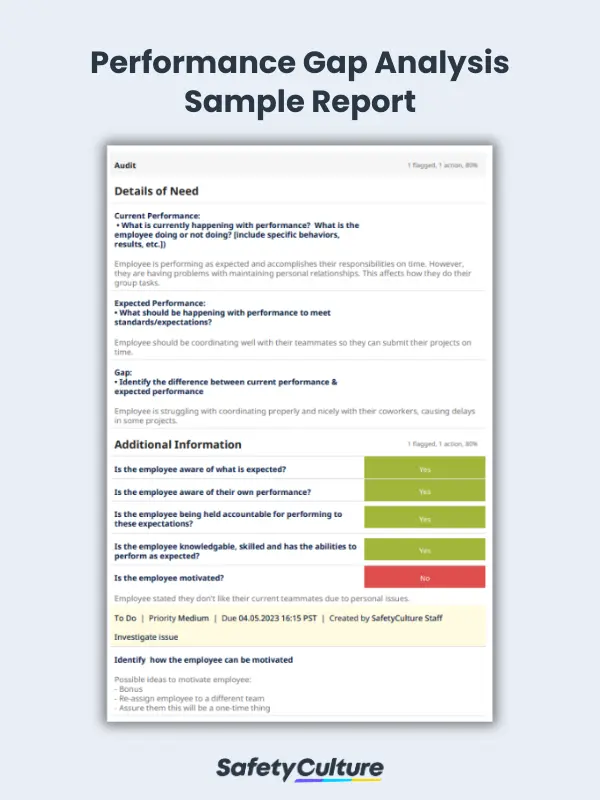What is a Performance Gap Analysis?
A performance gap analysis is a process that aims to determine what an employee is lacking in terms of performance or a position’s responsibilities. It is often used to help determine what other skills or training an employee might need and how to carry it out. A templated document is usually utilized to help carry this out more effectively.
Benefits
Conducting a performance gap analysis can bring several benefits to an organization and employee growth, including:
- Improved communication and teamwork: Conducting a performance gap analysis can help improve communication and teamwork within your team. By gaining a better understanding of organizational goals and objectives, you can encourage your employees to work more unitedly.
- Enhanced productivity: Identifying the gaps in your employees’ performance and developing strategies to address them helps lead to a better work environment.
- Cost savings: Addressing performance gaps can help organizations and leaders eliminate waste and inefficiencies in their processes and tasks, which can result in cost savings.
- Better decision-making: A performance gap analysis can provide organizations with valuable insights into their operations, which can encourage better decision-making.
How to Conduct a Performance Gap Analysis
A performance gap analysis can be done in many ways depending on how an organization operates. The employees’ individuality is also considered, as each person has different strengths, weaknesses, and performance levels.
However, most conduct a performance gap analysis following these steps:
- Step 1: Gathering data and information — Before anything else, you must first collect and analyze all data related to the performance of your employee in relation to your organization or system.
- Step 2: Identifying performance gaps — The next step is to identify the gaps in your employees’ performance between their actual performance and their desired performance levels or goals. You can do this by comparing their performance metrics to industry standards, benchmarking them and their goals against competitors, or comparing their performance to your organization’s internal goals and objectives.
- Step 3: Determining root causes of performance gaps — After identifying your employees’ performance gaps, you and your employees should then determine the underlying causes behind them.
- Step 4: Providing solutions and recommendations — Finish off your performance gap analysis by developing solutions and recommendations. This may involve implementing process improvements, providing training or resources, or reallocating resources to areas with higher priority.
Why Use a Template for This Process?
The best way to do a performance gap analysis is with the help of a templated document with you. A performance gap analysis template can help streamline the process of identifying and addressing gaps, as it can help you keep track of what questions to ask and what steps to take. It can also help with better documentation, ensuring you monitor your employees’ progress and goals.
A digital performance gap analysis template specifically can be a very beneficial tool in the long run. Some things it can help with are:
- Ensuring the life and storage of your documents, as you can store a digital performance gap analysis template in the cloud
- Reporting and documenting issues with performance and the corrective actions taken for them
- Conducting performance gap analyses anytime and anywhere
- Creating a more working experience by allowing you to integrate your existing work software with your template to better track progress
What to Include in a Performance Gap Analysis Template
A performance gap analysis template report should be structured in a clear and concise manner. While each organization, team, and leader may have different templates, they typically consist of the following sections:
- Introduction: This section will prompt you to provide an overview of the purpose and scope of the report, as well as any background information that is relevant to the analysis. Some things to include here are the employee’s details and the name of the manager in charge of the analysis for easy reference.
- Analysis of actual and desired performance levels: Next, analyze the employee’s current performance levels and their desired or expected performance levels.
- Identification of performance gaps: Coordinate with the employee and identify the gaps between their actual and ideal performance levels.
- Root causes of performance gaps: This section should analyze the underlying causes of the performance gaps identified in the previous section. This may involve further analyzing or gathering additional data to identify the root causes.
- Solutions and recommendations for improvement: This section should provide recommendations to address the performance gaps and improve overall performance. These recommendations may involve process improvements, providing training or resources, or reallocating resources to areas with higher priority.
Here is a performance gap analysis example report as reference:
FAQs about Performance Gap Analysis
A performance gap analysis can also be used for businesses and organizations as a whole. By conducting a performance gap analysis on groups, you can better understand your points for improvement and how to achieve your collective goals.
The other types of gap analysis are:
- Product gap analysis
- Financial gap analysis
- Human Resource (HR) gap analysis
- Needs gap analysis




